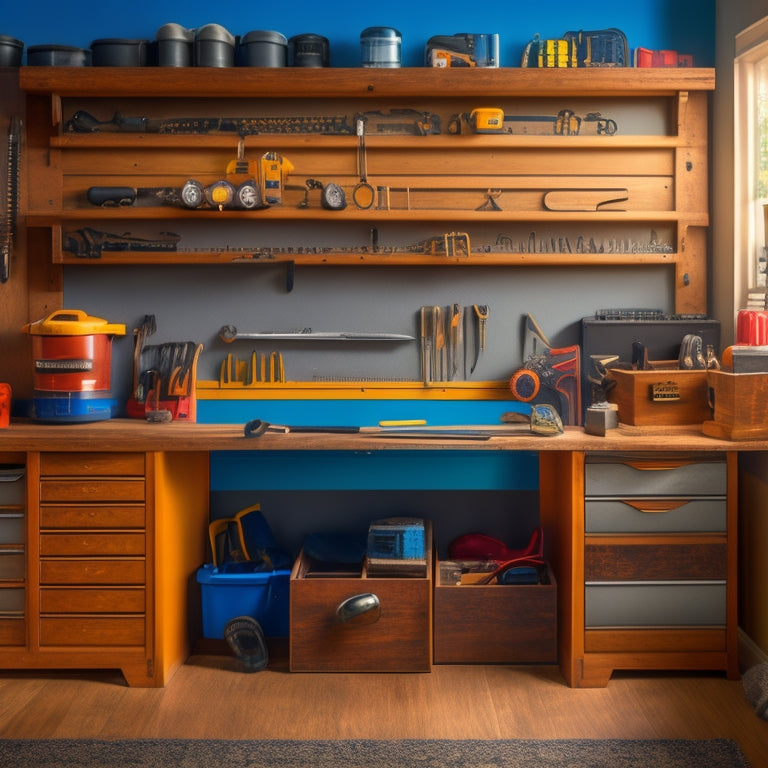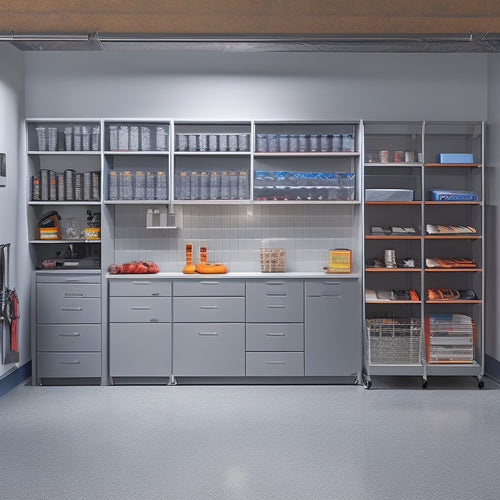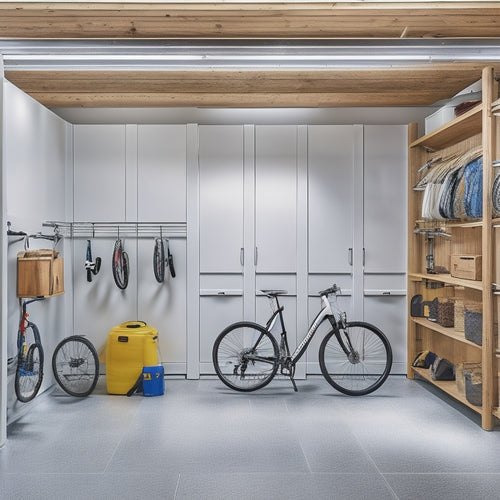
Essential Workbench Storage Ideas for a Clutter-Free Workspace
Share
You'll want to start by maximizing your vertical storage space by installing shelves, hooks, or pegboards on walls or ceilings to keep bulky items like power tools off the floor. Consider utilizing hidden compartments like secret drawers or sliding shelves to store infrequently used tools and supplies. Next, organize your tools by frequency of use, storing daily essentials in easy-to-reach areas. Implement a drawer storage system with dividers and labels to keep similar tools separated. Finally, label and signpost your storage bins and drawers with clear, concise labels. By implementing these strategies, you'll be well on your way to a clutter-free workspace - and there's even more you can do to optimize your space.
Key Takeaways
- Install shelves, hooks, or pegboards on walls or ceilings to maximize vertical storage space and keep frequently used tools within easy reach.
- Utilize hidden compartments like secret drawers, sliding shelves, and hidden cabinets to store valuable or infrequently used items.
- Organize tools by frequency of use, storing daily use tools in designated areas and seasonal tools in separate storage to maintain a clutter-free workspace.
- Implement a drawer storage system with dividers, pull-out shelves, and sturdy construction to keep tools organized and easily accessible.
- Use labeling and signposting with categorization, color-coding, and clear labels to quickly identify contents of storage bins and drawers.
Maximizing Vertical Storage Space
Maximize your workbench's vertical storage space by installing shelves, hooks, or a pegboard on the walls or ceiling above your workstation. This will help keep frequently used tools and materials within easy reach, freeing up precious counter space for your projects.
Wall-mounted shelves are ideal for storing bulky items, such as power tools or equipment, while hooks can be used to hang items like cords, hoses, or accessories.
A pegboard is another great option for pegboard organization, allowing you to customize your storage with hooks, bins, and other accessories suited to your specific needs. When choosing a pegboard, consider the weight capacity and material to guarantee it can support the items you plan to store.
Additionally, make certain to follow the manufacturer's installation instructions and take necessary safety precautions to avoid accidents or damage. By maximizing your vertical storage space, you'll be able to work more efficiently and safely, with everything you need right at your fingertips.
Utilizing Hidden Compartments Effectively
Your workbench's hidden compartments can be a rich source of storage potential, providing a clever way to stash treasured tools, supplies, or equipment out of sight yet within easy reach. By incorporating hidden shelves and secret drawers into your workbench design, you can keep your workspace organized and clutter-free.
Here is a breakdown of how you can make use of hidden compartments effectively:
| Compartment Type | Ideal Storage Items | Benefits |
|---|---|---|
| Hidden shelves above the work surface | Infrequently used tools, manuals, or equipment | Keeps items out of the way, yet accessible |
| Secret drawers in the workbench frame | Valuables, important documents, or sensitive equipment | Provides secure storage for prized items |
| Sliding compartments under the work surface | Frequently used supplies, such as sandpaper or drill bits | Keeps essential items within easy reach |
| Hidden cabinets in the workbench legs | Large or bulky equipment, such as power tools or compressors | Maximizes storage capacity while maintaining a clean workspace |
Organizing Tools by Frequency
As you work on a project, you likely find yourself reaching for certain tools more frequently than others. This is where organizing tools by frequency comes in – an essential step in maintaining a clutter-free workspace.
By categorizing your tools based on how often you use them, you can guarantee that the most frequently used ones are easily accessible, reducing the time spent searching for them.
Divide your tools into three categories: daily, weekly, and seasonal use. Store daily use tools in a designated area, such as a pegboard or a toolbox, for quick access.
Weekly use tools can be stored in a nearby cabinet or on a shelf. Seasonal tools, like winter-specific equipment, can be stored in a separate area or even rotated out seasonally to free up space.
This seasonal rotation guarantees that your workspace remains organized and clutter-free throughout the year.
Implementing Drawer Storage Systems
By the time you've organized your tools by frequency, you're likely enthusiastic to tackle the next step in enhancing your workbench storage.
Implementing a drawer storage system is an essential aspect of maintaining a clutter-free workspace. Start by evaluating your drawer space and determining the ideal layout for your tools. You can maximize storage capacity by installing drawer dividers, which will keep similar tools separated and prevent clutter from building up.
Next, consider installing pull-out shelves or trays to increase accessibility to your tools. This will save you time and energy when searching for a specific tool, reducing the risk of accidents caused by rummaging through cluttered drawers.
Confirm the shelves are sturdy and securely attached to the drawer to prevent them from collapsing under the weight of your tools.
Labeling and Signposting Essentials
A well-organized workbench relies on clear identification of stored tools and materials. You'll avoid confusion and wasted time searching for misplaced items by implementing an effective labeling and signposting system.
Start by categorizing your tools and materials into groups, such as hand tools, power tools, and consumables.
Assign a unique color to each category and use color-coded labels to identify the contents of each storage bin or drawer. This visual system allows you to quickly locate the item you need. For example, you can use red labels for hand tools, blue for power tools, and green for consumables.
Magnetic signs can be used to label metal storage bins or cabinets, providing a flexible and adjustable labeling solution.
Confirm the labels are clear, concise, and easy to read, even from a distance.
Frequently Asked Questions
How Do I Store Large or Bulky Items in a Small Workspace?
You'll maximize space by utilizing vertical storage options, like wall-mounted shelves or pegboards, and under-bench solutions, such as slide-out bins or pedestals, to safely store large or bulky items, keeping your workspace organized and hazard-free.
Can I Customize Storage Solutions to Fit My Specific Needs?
As you traverse the labyrinth of your workspace, imagine a bespoke map guiding you to hidden treasures. You can craft custom shelving and personalized drawers to fit your unique needs, ensuring a symmetrical harmony between form and function.
Are Modular Storage Systems Worth the Investment?
You're considering investing in modular storage systems, and it's worth it - they offer modular flexibility, allowing you to adapt to changing needs, and cost efficiency, as you only pay for what you need, ensuring a safe and organized workspace.
How Do I Prevent Rust and Corrosion in Metal Storage Containers?
As you fortify your metal storage containers, don't let rust and corrosion creep in like sneaky thieves; apply a rust-inhibiting coating, use desiccant packets, and make certain airtight seals to safeguard your tools and materials, keeping them safe from the corrosive clutches of time.
Can I Use Storage Bins and Baskets in a Humidity-Controlled Environment?
You can safely use storage bins and baskets in a humidity-controlled environment if you choose bins made from rust-resistant materials, like stainless steel or plastic, and make certain they're properly sealed to minimize humidity effects on contents.
Conclusion
You've optimized your workbench storage, and now your workspace is a haven of efficiency. But you might be thinking, "What about those occasional, bulky projects that still clutter my space?" Visualize this: a retractable overhead storage rack, effortlessly sliding out of the way when not in use, freeing up floor space for those infrequent, oversized tasks. With these essential workbench storage ideas, you've conquered clutter, and your workspace is now a showcase in productivity.
Related Posts
-

Building a Garage Storage System With Built-Ins
You're about to build a garage storage system with built-ins that fits your unique needs, starting by evaluating your...
-

Top 5 Small Tool Organizers for Your Workshop
You're looking to optimize your workshop's efficiency with high-quality small tool organizers. Compact storage soluti...
-

Modular Garage Organizers for Clutter-Free Spaces
You're likely wasting precious space in your garage due to inefficient storage and poor organization, but modular gar...


